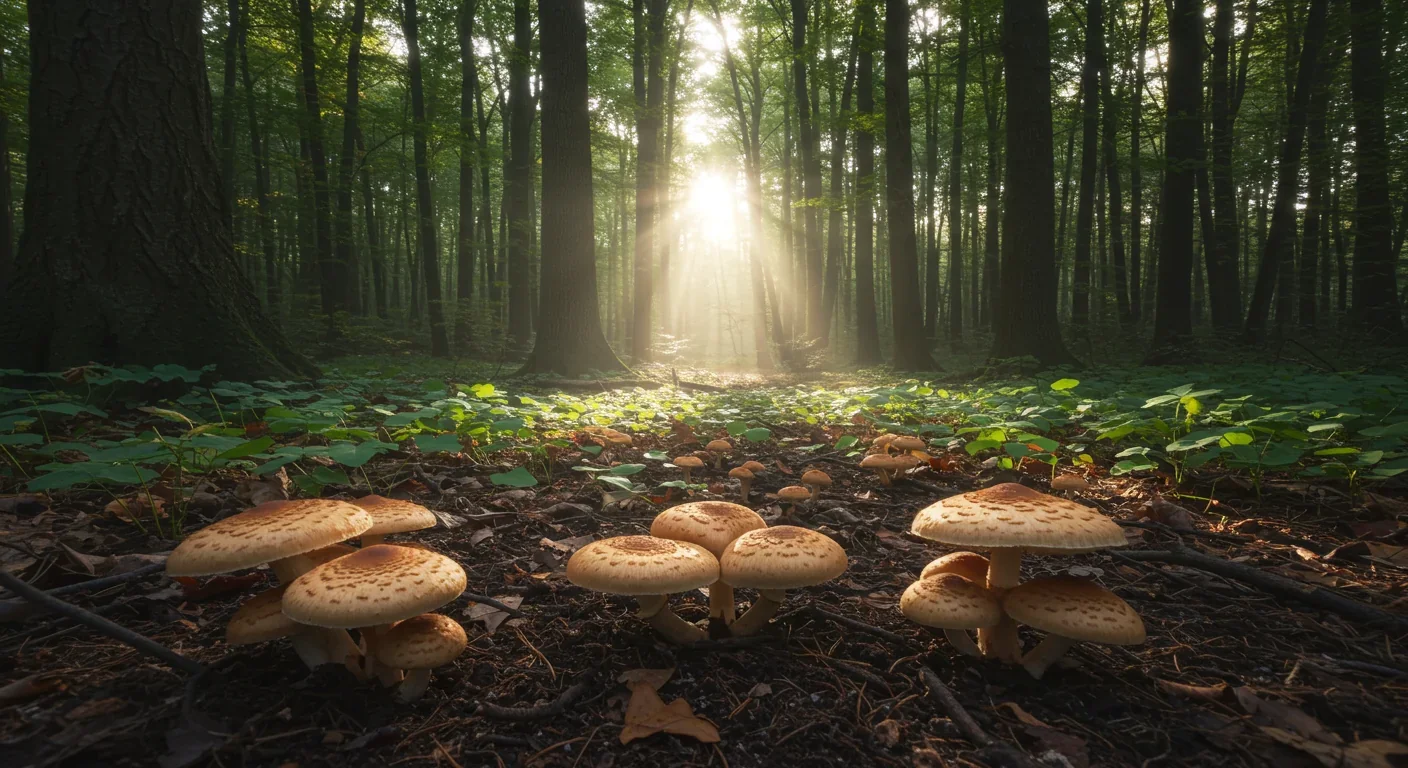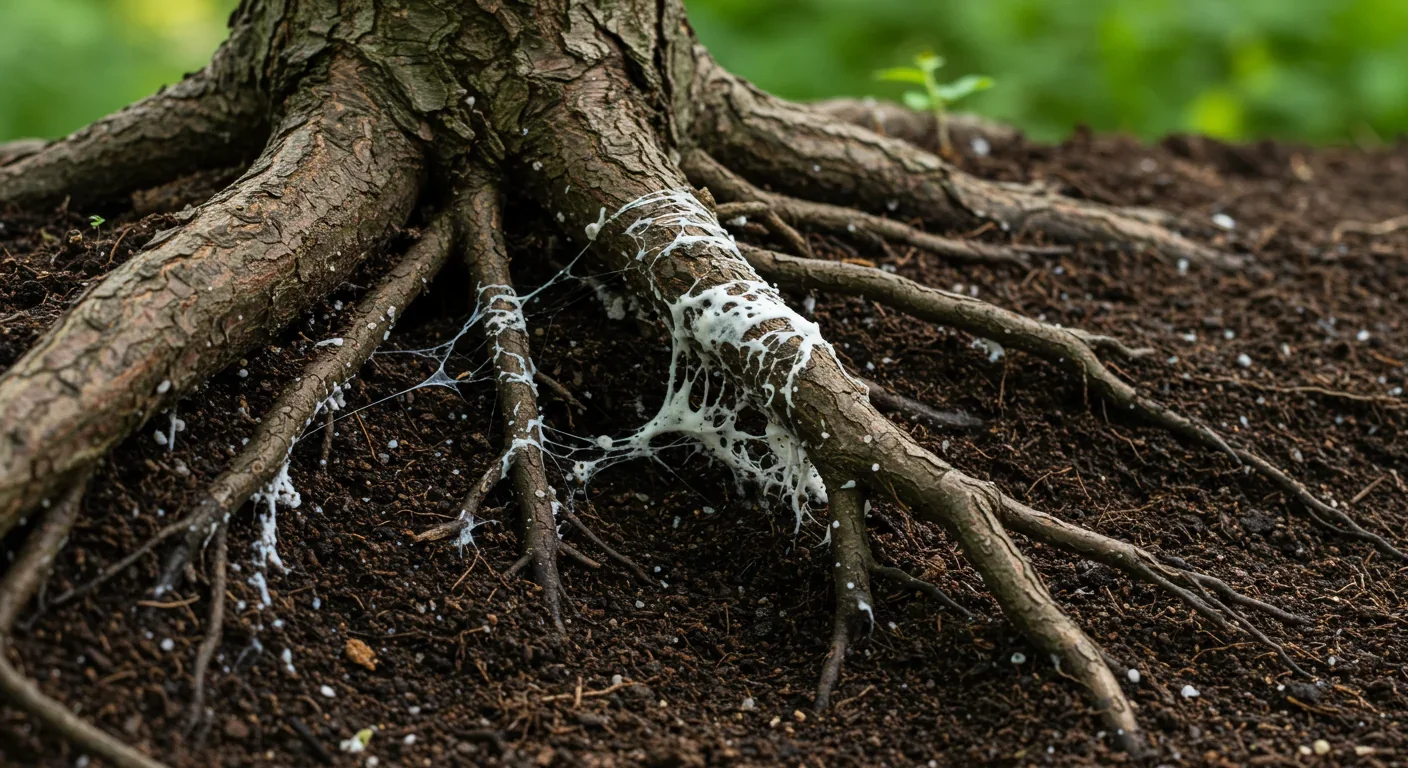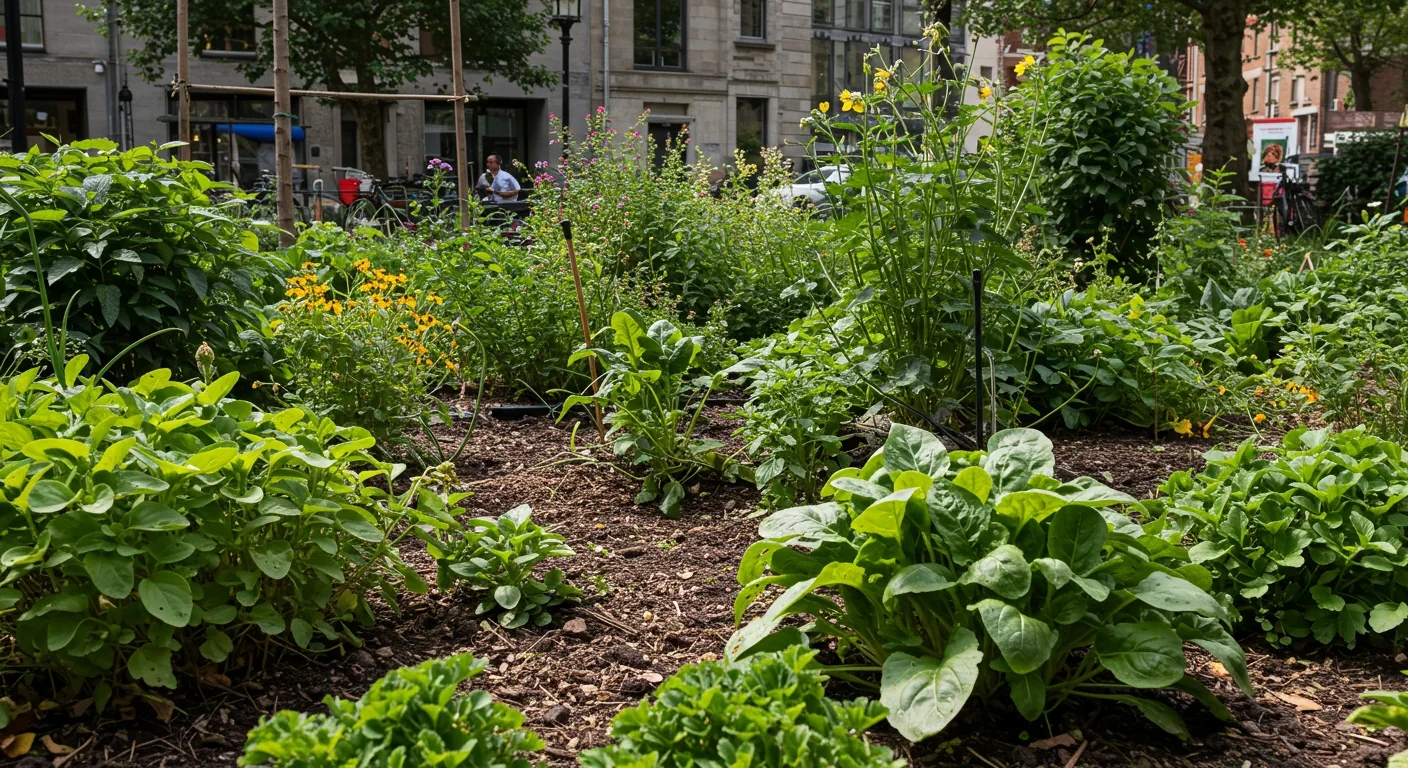Bombardier Beetle Chemical Defense: Nature's Micro Engine

TL;DR: Beneath every forest lies an underground fungal network connecting trees in a biological internet that shares nutrients, transmits danger warnings, and creates collective resilience far beyond what individual trees could achieve alone.

Walk through any forest and you're surrounded by giants competing for light, water, and nutrients. At least, that's what we thought. Turns out, beneath our feet lies a hidden internet connecting every tree, shrub, and sapling in an underground network more intricate than anything humans have built. Scientists call it the wood wide web, and it's rewriting everything we know about how forests survive, communicate, and thrive. These fungal highways don't just move nutrients, they transmit warning signals about danger, redistribute resources from strong trees to struggling seedlings, and create a collective intelligence that makes the forest far more resilient than any individual tree could ever be. Understanding this system could transform how we grow food, design cities, and fight climate change.
The wood wide web exists because of mycorrhizal fungi, microscopic organisms that form symbiotic partnerships with plant roots. A single teaspoon of healthy forest soil can contain up to 100 meters of fungal threads called hyphae. These threads weave through the soil, wrapping around or penetrating tree roots to create mycorrhizae, literally "fungus roots." The exchange is elegant in its simplicity: trees produce sugars through photosynthesis and share them with the fungi, while the fungi, with their vastly expanded surface area, absorb water and critical nutrients like phosphorus and nitrogen from the soil and deliver them to the trees. This partnership is so effective that mycorrhizal connections can increase phosphorus uptake by up to 50%.
What makes this truly remarkable is the scale. These aren't isolated one-to-one relationships. A single fungal network can connect hundreds of trees across multiple species, creating what ecologist Suzanne Simard describes as an interconnected forest community. The largest known organism on Earth is actually a honey fungus in Oregon whose mycelial network spans almost four square miles. Within that network, nutrients, water, and chemical signals flow constantly between trees, creating a living, breathing system that functions more like a superorganism than a collection of individuals.
Dr. Simard's pioneering research in the 1990s used radioactive carbon isotopes to trace nutrient movement through these networks. She discovered that large, well-established "mother trees" actively send extra carbon to shaded saplings, including their own offspring, giving them the energy they need to survive until they can reach sunlight themselves. This wasn't passive leakage, it was targeted resource allocation, a form of forest parenting mediated by fungal intermediaries.
The wood wide web doesn't just move nutrients. It's a communication network that transmits defense signals between trees. When a tree is attacked by pests like aphids or leaf-eating insects, it releases chemical defense compounds into the fungal network. These signals travel through the hyphae to neighboring trees, which then preemptively ramp up their own defensive enzymes, producing repellent substances before the threat even arrives.
Research on leguminous plants showed that when one plant suffers an aphid infestation, connected neighbors begin emitting volatile compounds within six hours that attract natural predators of aphids. Even more striking, experiments with tomato plants demonstrated that mechanical damage to one plant triggers stress-resistant enzyme production in connected plants that haven't been touched. The network creates an induced state of readiness across the entire forest community.
This isn't just chemical messaging. Recent research by Professor Andrew Adamatzky analyzed electrical spikes generated by mycelium and found patterns that closely resemble the statistical structure of human language. The spikes cluster in "trains" whose distribution and length mirror linguistic patterns, suggesting the fungi may be encoding far more complex information than simple danger warnings. Some researchers now believe mycorrhizal networks transmit data about environmental conditions, resource availability, and ecosystem health across vast distances.
Not all trees are equal in the wood wide web. Simard's research revealed that forests have hub trees, older, larger individuals with massive root systems that serve as central connection points in the fungal network. These mother trees can be connected to hundreds of other trees, funneling resources to where they're needed most. When a mother tree is threatened or dying, it shifts its carbon to neighboring trees, essentially downloading its accumulated resources to the next generation before it goes.
This has profound implications for forest resilience. When logging operations remove the biggest, oldest trees, they're not just taking timber, they're dismantling the forest's circulatory system. Clear-cutting practices that remove all trees of a certain size effectively destroy the mycorrhizal network, leaving the soil degraded and making regeneration far more difficult. The competition-focused forestry model that treats trees as isolated economic units fundamentally misunderstands how forests actually work.
Indigenous land management practices, by contrast, have long recognized these interconnections. Traditional forestry methods that maintain diverse, mixed-age stands preserve the fungal networks and the ecosystem services they provide. Forests managed according to these principles show greater biodiversity, better carbon sequestration, and higher resilience to drought, disease, and climate stress.

Mycorrhizal networks play a critical role in climate regulation. Trees pull carbon dioxide from the atmosphere through photosynthesis, but a significant portion of that carbon ends up underground. Plants transfer carbon to mycorrhizal fungi, which use it to build their extensive hyphal networks. When those hyphae die, the carbon becomes locked in the soil, sometimes for centuries.
The scale is staggering. Mycorrhizal fungi help draw an estimated 13 billion tons of carbon into the soil annually, nearly one-third of global emissions from fossil fuels. This makes healthy fungal networks one of Earth's most important carbon sinks. Soil disturbance from conventional agriculture and forestry releases that stored carbon back into the atmosphere, while also disrupting the networks that could be capturing more.
After wildfires, droughts, or human disturbance, mycorrhizal fungi are often the first responders, helping plants regenerate and rebuild root systems. They bind soil particles together, reduce erosion, and improve water retention, creating conditions that allow forests to recover faster and more completely than they could without these underground allies.
Understanding the wood wide web has major implications for agriculture. Industrial farming typically treats soil as an inert medium for holding plants and applying inputs. Monoculture crops, heavy tilling, and chemical fertilizers all disrupt mycorrhizal networks, forcing farmers into a cycle of external inputs to replace the ecosystem services the fungi would have provided for free.
A different approach is emerging. In Castel del Giudice, Italy, a reforestation project created a multifunctional forest by planting white firs, ash trees, and mycorrhizal hazelnuts together. The mixed-species stand produces high-quality timber, biodiversity, hazelnuts, and truffles, all supported by the underground fungal network. The truffles themselves are mycorrhizal fungi, and their cultivation depends on maintaining healthy networks that simultaneously support tree growth and produce high-value crops.
Regenerative agriculture systems are increasingly designed to protect and enhance mycorrhizal activity. No-till farming preserves fungal hyphae that would be destroyed by plowing. Cover crops maintain living roots in the soil year-round, feeding the fungi and keeping networks intact. Diverse crop rotations support a wider range of mycorrhizal species, increasing resilience. Early results show these systems can match or exceed conventional yields while using fewer inputs, sequestering more carbon, and building rather than depleting soil health.
Measuring mycorrhizal activity is becoming a key metric for soil health. Techniques range from simple visual root assessments to sophisticated isotopic tracing using radioactive phosphorus to track nutrient movement through fungal pathways. Some farmers now track root colonization percentages and spore counts as indicators of soil biological function, treating mycorrhizae as infrastructure just as important as irrigation systems.
Cities are beginning to recognize that trees planted in isolation perform poorly compared to trees that can access mycorrhizal networks. Traditional urban tree planting often involves individual pits of imported soil surrounded by compacted subsoil or pavement, creating hostile environments where fungal networks can't form. These trees suffer higher mortality, require constant maintenance, and provide fewer ecosystem services.
Progressive urban forestry now focuses on creating connected soil volumes where mycorrhizal networks can establish. Techniques include continuous tree trenches with shared soil volumes, structural soils that can bear pavement loads while remaining porous enough for root and fungal growth, and preserving existing soil networks when new trees are added to established landscapes. Cities like Portland and Seattle are piloting projects that inoculate new plantings with native mycorrhizal fungi, essentially seeding the wood wide web in urban environments.
The benefits extend beyond tree health. Mycorrhizal networks improve urban storm water management by increasing soil porosity and water infiltration. They sequester more carbon in city soils. They can even help with soil remediation, as some mycorrhizal fungi break down or sequester soil pollutants, cleaning contaminated urban land while supporting plant growth.
The wood wide web has captured public imagination, but not all scientists are convinced the story is as straightforward as it seems. Some researchers argue that while mycorrhizal networks clearly exist and facilitate nutrient transfer, the evidence for intentional resource sharing or complex communication remains thin. They point out that most nutrient movement through networks might be simple diffusion rather than directed flow, and that the fungi themselves may be exploiting plants as much as helping them.
Critics also note that much early research was conducted in controlled greenhouse environments that don't fully replicate the complexity of natural forests. Field studies are harder to execute and sometimes produce contradictory results. The role of mother trees, in particular, has been questioned, with some scientists suggesting that larger trees may simply have more fungal connections because they have larger root systems, not because they're playing a special functional role.
The debate is healthy. It's pushing researchers to design better experiments, gather more field data, and think carefully about how to interpret observations of these incredibly complex underground systems. What's not in dispute is that mycorrhizal networks exist, that they connect trees across forests, that they move nutrients and chemical signals, and that disrupting them has negative consequences for forest health. The precise mechanisms and evolutionary logic are still being worked out.

As climate change intensifies, forests face unprecedented stress from drought, heat, pests, and fire. The wood wide web may be our best ally in building resilience. Networks that connect diverse tree species and ages can buffer individual trees against local stressors, redistributing resources to where they're needed most. Forests with intact mycorrhizal networks show greater drought tolerance, faster recovery from disturbance, and more stable carbon sequestration.
Conservation strategies are shifting accordingly. Instead of focusing solely on protecting individual rare species or maximizing timber volume, forward-thinking forest managers are prioritizing network integrity. This means maintaining mother trees, preserving mixed-age stands, minimizing soil disturbance, and allowing natural regeneration wherever possible. Some are even actively restoring degraded forests by reintroducing mycorrhizal fungi, essentially rewiring the wood wide web in damaged ecosystems.
The technology to map mycorrhizal networks is improving rapidly. DNA sequencing can now identify the full diversity of fungal species in soil samples. Researchers are beginning to create network maps showing which trees are connected and how strongly, information that could guide selective logging, fire management, and restoration work. Within a decade, we may be able to monitor forest health by assessing fungal network structure, catching problems before they become visible aboveground.
The wood wide web challenges the foundational metaphor of modern economics: the isolated individual competing for scarce resources. Forests teach a different lesson. Success comes from connection, from systems that share resources, from networks that make the collective stronger than any individual. Trees that join robust mycorrhizal networks grow faster, live longer, and produce more offspring than trees that go it alone.
This has implications beyond forestry and agriculture. The same network thinking is transforming ecology, urban design, and even social science. We're learning that resilient systems, whether ecosystems or human communities, are characterized by dense, diverse connections that allow resources and information to flow where needed. The wood wide web is a model for how to build systems that last.
For anyone who spends time in forests, this knowledge changes how you see the landscape. That carpet of leaves and soil isn't just the forest floor, it's the nervous system of an organism that stretches for miles. Those towering pines aren't competing, they're collaborating. The forest isn't a collection of individuals struggling alone, it's a community that survives by taking care of its members.
And it's a community we're part of. Every decision we make about land use, agriculture, and conservation either strengthens or weakens these networks. The question isn't whether we impact the wood wide web, but whether we'll be wise enough to work with it rather than against it. The trees have been figuring out cooperation for millions of years. Maybe it's time we learned from them.

Recent breakthroughs in fusion technology—including 351,000-gauss magnetic fields, AI-driven plasma diagnostics, and net energy gain at the National Ignition Facility—are transforming fusion propulsion from science fiction to engineering frontier. Scientists now have a realistic pathway to accelerate spacecraft to 10% of light speed, enabling a 43-year journey to Alpha Centauri. While challenges remain in miniaturization, neutron management, and sustained operation, the physics barriers have ...

Epigenetic clocks measure DNA methylation patterns to calculate biological age, which predicts disease risk up to 30 years before symptoms appear. Landmark studies show that accelerated epigenetic aging forecasts cardiovascular disease, diabetes, and neurodegeneration with remarkable accuracy. Lifestyle interventions—Mediterranean diet, structured exercise, quality sleep, stress management—can measurably reverse biological aging, reducing epigenetic age by 1-2 years within months. Commercial ...

Data centers consumed 415 terawatt-hours of electricity in 2024 and will nearly double that by 2030, driven by AI's insatiable energy appetite. Despite tech giants' renewable pledges, actual emissions are up to 662% higher than reported due to accounting loopholes. A digital pollution tax—similar to Europe's carbon border tariff—could finally force the industry to invest in efficiency technologies like liquid cooling, waste heat recovery, and time-matched renewable power, transforming volunta...

Humans are hardwired to see invisible agents—gods, ghosts, conspiracies—thanks to the Hyperactive Agency Detection Device (HADD), an evolutionary survival mechanism that favored false alarms over fatal misses. This cognitive bias, rooted in brain regions like the temporoparietal junction and medial prefrontal cortex, generates religious beliefs, animistic worldviews, and conspiracy theories across all cultures. Understanding HADD doesn't eliminate belief, but it helps us recognize when our pa...

The bombardier beetle has perfected a chemical defense system that human engineers are still trying to replicate: a two-chamber micro-combustion engine that mixes hydroquinone and hydrogen peroxide to create explosive 100°C sprays at up to 500 pulses per second, aimed with 270-degree precision. This tiny insect's biochemical marvel is inspiring revolutionary technologies in aerospace propulsion, pharmaceutical delivery, and fire suppression. By 2030, beetle-inspired systems could position sat...

The U.S. faces a catastrophic care worker shortage driven by poverty-level wages, overwhelming burnout, and systemic undervaluation. With 99% of nursing homes hiring and 9.7 million openings projected by 2034, the crisis threatens patient safety, family stability, and economic productivity. Evidence-based solutions—wage reforms, streamlined training, technology integration, and policy enforcement—exist and work, but require sustained political will and cultural recognition that caregiving is ...

Every major AI model was trained on copyrighted text scraped without permission, triggering billion-dollar lawsuits and forcing a reckoning between innovation and creator rights. The future depends on finding balance between transformative AI development and fair compensation for the people whose work fuels it.